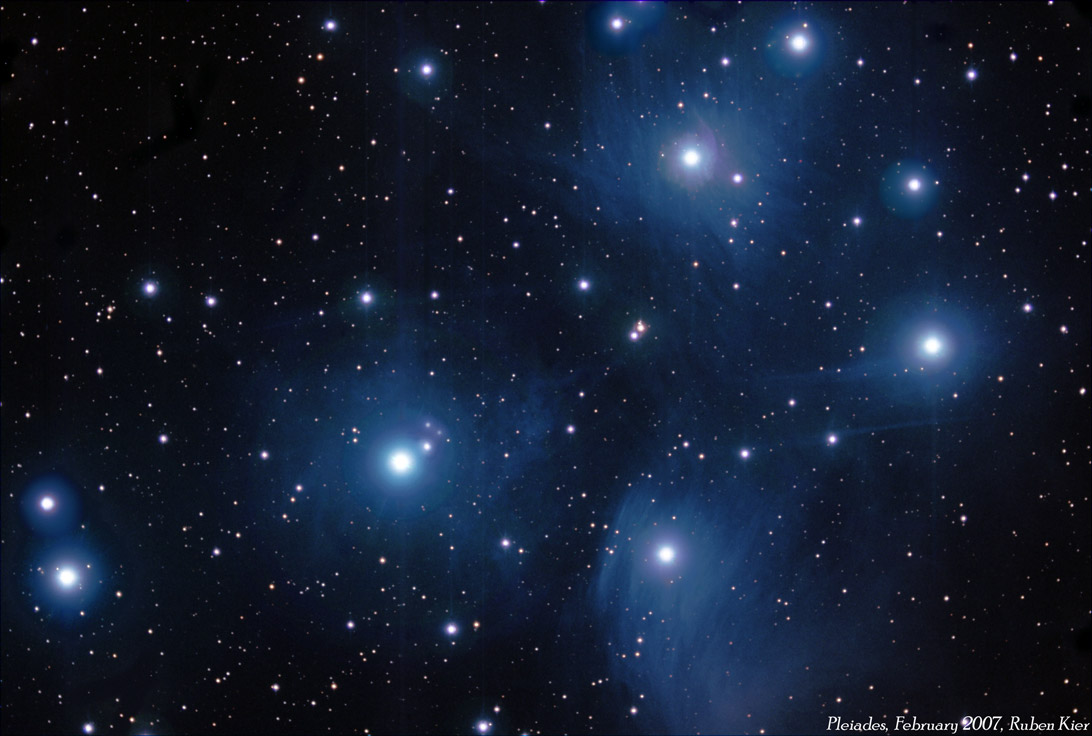| Pleiades Cluster - M45 |
The M45 Pleiades Cluster in Taurus contains 100 stars spread across a sphere 14 light-years wide at a distance of 400 light years. Termed the "Seven Sisters" in mythology, at least seven
of the stars can be seen with the naked eye making a small dipper shape. Binoculars will reveal a splash of dozens of brilliant blue-white stars. A telescope can show faint nebulosity of
interstellar dust, that appears blue in this image. The nebulosity represents the remnant of the dust and gas cloud from which these young stars were born.
Imaging this object is a challenge with most CCD cameras, because the stars are so bright compared to the surrounding nebula. In my first two attempts, shown at the bottom of the page, I
used an ST10 XME camera, and then spent hours post-proccessing the images in Photoshop to get rid of the "bloom" around the brighter stars. Five years ago, I acquired a more modest
ST2000XM camera, which has "antiblooming" protection, that suppresses excess light from bright stars from spilling into adjacent pixels in the camera. I also used a shorter focal length
telescope, the Takahashi Sky90, with a reducer to yield a focal length of about 405 mm, which yields a wider field-of-view. The result, combining 50 minutes of red and green exposures
with 90 minutes of blue exposures (all unbinned), is displayed below. The halos around the brighter stars are caused by internal reflections between the camera and the overlying filters.
My most recent attempt is shown above. I used an Astro-Physics 130mm refractor with a reducer to yield a focal length of about 600 mm. A QSI-583 camera, also antiblooming, helped
to control the bloating of the brighter stars. A total of 66 minutes red, 68 minutes green, and 80 minutes blue exposures (all unbinned 2 minute subexposures) were combined for the image.
of the stars can be seen with the naked eye making a small dipper shape. Binoculars will reveal a splash of dozens of brilliant blue-white stars. A telescope can show faint nebulosity of
interstellar dust, that appears blue in this image. The nebulosity represents the remnant of the dust and gas cloud from which these young stars were born.
Imaging this object is a challenge with most CCD cameras, because the stars are so bright compared to the surrounding nebula. In my first two attempts, shown at the bottom of the page, I
used an ST10 XME camera, and then spent hours post-proccessing the images in Photoshop to get rid of the "bloom" around the brighter stars. Five years ago, I acquired a more modest
ST2000XM camera, which has "antiblooming" protection, that suppresses excess light from bright stars from spilling into adjacent pixels in the camera. I also used a shorter focal length
telescope, the Takahashi Sky90, with a reducer to yield a focal length of about 405 mm, which yields a wider field-of-view. The result, combining 50 minutes of red and green exposures
with 90 minutes of blue exposures (all unbinned), is displayed below. The halos around the brighter stars are caused by internal reflections between the camera and the overlying filters.
My most recent attempt is shown above. I used an Astro-Physics 130mm refractor with a reducer to yield a focal length of about 600 mm. A QSI-583 camera, also antiblooming, helped
to control the bloating of the brighter stars. A total of 66 minutes red, 68 minutes green, and 80 minutes blue exposures (all unbinned 2 minute subexposures) were combined for the image.

Music - Beethoven 5th Symphony 1st Mvt

The image above was taken with an ST10XME camera and AP nosepiece reducer, to yield a focal length of about 700mm through a TEC140mm
refractor, at the Hidden Lake Observatory. The image combined 36 minutes red, 29 minutes green, and 31 minutes blue exposures, all obtained unbinned.
The image below, taken over three years earlier from my suburban backyard, represents a combination of 30 minutes luminance, 10 minutes each red
and green, and 15 minutes blue exposures. Images were taken through a 4" refractor, 0.75x reducer, and ST10XME camera.
refractor, at the Hidden Lake Observatory. The image combined 36 minutes red, 29 minutes green, and 31 minutes blue exposures, all obtained unbinned.
The image below, taken over three years earlier from my suburban backyard, represents a combination of 30 minutes luminance, 10 minutes each red
and green, and 15 minutes blue exposures. Images were taken through a 4" refractor, 0.75x reducer, and ST10XME camera.

